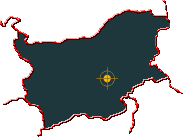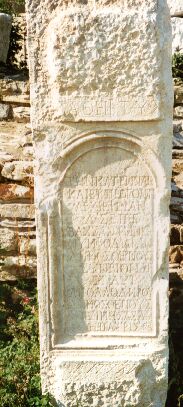|
|
|
 Name:
Стара Загора (Stara Zagora).
The town changed its name not juts one.
First it was known as Beroe, after that the Romans renamed it and called it
Augusta Trayana. After the Romans it became Beroe again and later
Boruj. Other names such as Verea and Irinopolis
refer to the same place. The Ottomans called it Eski Zagra, from which the present name derives.
The new name means Old Zagra. Of course there's also a New Zagra (Nova Zagora)
not far from Old Zagora. Another common spelling is Stara Sagora.
Name:
Стара Загора (Stara Zagora).
The town changed its name not juts one.
First it was known as Beroe, after that the Romans renamed it and called it
Augusta Trayana. After the Romans it became Beroe again and later
Boruj. Other names such as Verea and Irinopolis
refer to the same place. The Ottomans called it Eski Zagra, from which the present name derives.
The new name means Old Zagra. Of course there's also a New Zagra (Nova Zagora)
not far from Old Zagora. Another common spelling is Stara Sagora.
Location:
The town is located between →Plovdiv in the east and →Burgas
at the Black Sea coast. It sprawls along the southern foot of Sarnena Gora (Sarnena Mountains),
which are the foothills of Stara Planina (Balkan mountains). When you cross the famous Shipka Pass
in the north, you can easily get to →Veliko Tarnovo in North Bulgaria, which is not so far away.
South of Stara Zagora is the long Mountainous Thracian Plain.
Population: around 150,000 - Stara Zagora is one of the biggest cities of the country.
Orientation:
Since Stara Zagora was burnt down by the Ottomans during the reconquest, there's not much left of the historic, rather
Turkish looking old city centre. Bulgarians started to reconstruct the town after 1879 and opted for a practical solution,
involving consequently modern urban development. The result is a strict chequered pattern
with one square measuring either 330 m² or 660 m² with streets being sorted by importance - they are
10, 16 or 20 m wide. Which makes it quite difficult to get lost in Stara Zagora (but I'm afraid some people manage to get lost everywhere).
Right in the centre is a main square, which has the shape of the former bazaar.
Unfortunately, most mosques haven't survived the reconstruction of the town.
The biggest mosque (Eski Mosque) is used as a church today.
Stara Zagora is a rather modern place, but it's quite mixed - everywhere, ancient ruins and excavation sites
can be found between new appartment blocks. Today, villages and towns in the vicinity of Stara Zagora are still facing the
consequences of excessive environmental pollution.
History:
Although Stara Zagora is one of the oldest towns of Bulgaria, it's much less famous than other historic towns such as
→Plovdiv or →Nesebar. This is probably due to the fact
that most of the historic centre was destroyed during the above-mentioned reconstruction of the town.

| |
Ancient Greek stele in Zagora
|
Later, the vast Roman empire conquered present-day Bulgaria and created the province Thracia. At that time, Beroe was
the second biggest city in the province (No 1 of course was →Plovdiv).
Beroe was renamed Augusta Trayana and flourished for a long time. One of the reasons for the success
was the fact, that Augusta Trayana marked the junction of several trade routes between Middle Europe, Asia Minor and the
Roman Empire. Many Greeks lived in town (see picture of the stele), and Romans as well as Thracians created marvellous
baths, an advanced canalization and villas. Thanks to excessive excavation works, many remainings from Roman times can be seen
today.
After the decline of the Roman Empire, Augusta Trayana became Beroe again and remained an important town -
to be exactly, it was one of the biggest cities in the northern provinces of the Byzantine empire. During the
Second Bulgarian Empire, the place was called Boruj. The role of the city within the
empire didn't change much.
The Byzantine empire was replaced by the Ottomans. The Ottomans went in again in 1370 and levelled the town completely.
In order to rebuild it. After that, the place was known as Eski Zagra. Of course, many mosques
were erected - among them Eski (=old) Mosque. Unfortunately, the minarets of Eski mosque were blown
up a few years ago. During the Ottoman occupation, the town was famous for its
silk, leather and copper processing industry. In 1875, Bulgarians initiated an uprising against the Ottoman
rulers, but this was brutally crushed. Only three years later, the Russians liberated Eski Zagra - however, the town was levelled again
by the Ottomans. After the final liberation, Zagra became a part of the autonomous province
East Rumelia. A Czech architect was appointed to organize the reconstruction of the city.
And so the architect applied a completely new grid of streets without taking into account older buildings and streets. The result is
a strict chequered pattern, which is not new - already more than 1400 years before, towns like
→Xi'an in China and later on
→Nara in Japan were planned like this.
Since 1900, the town was about to be industrialized. In 1944, after the liberation of Bulgaria from the pro-fascist government,
Stara Zagora was declared an industrial zone with all its consequences for the environment. Nowadays, Stara Zagora is trying
hard to get rid of its image as a dull industrial town. Making the town more attractive to visitors is definitely a challenge, but at
least the historic potential is already there.
Getting there:
It's easy to get to Stara Zagora by bus or train from →Sofia, →Plovdiv and
→Burgas. Another railway line connects the town with
→Veliko Tarnovo and →Ruse in Northern Bulgaria.
The famous →Valley of Roses is only 20 km away to the north and easily accessible by bus.
The bus terminal and train station of Stara Zagora are very close to each other and can be found
in the south-west of the town, from where it's quite a long walk to the centre.
|